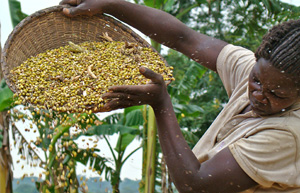
Aid agencies and governments are increasingly looking at ways to ensure that agricultural investments support proper nutrition, including one methodology being developed by the US Agency for International Development (USAID) and NGOs.
The “nutritional impact assessment tool”, was developed by USAID’s Infant and Young Child Nutrition Project (IYCN), led by PATH, CARE, the Manoff Group, and University Research Co., LLC.
“The tool would be a way for organizations designing or reviewing agricultural programmes to mitigate any risks or potential negative effects on nutrition – in other words a ‘do no harm’ approach,” said Michael Zeilinger, head of the nutrition division with USAID’s office of health, infectious disease and nutrition.
USAID is working with NGO partners to test the tool — a template for listing project objectives, food insecure groups, people’s nutritional status and possible impact of an agricultural project on each group. “As we start to design major agriculture programmes around value chains and increasing production (such as Feed the Future and Global Agriculture and Food Security Program), we should really remember that there are some practices in agriculture that may have potential negative effects on nutrition, and this is just to make sure that they’re thought through,” Zeilinger told IRIN.
For example, smallholders might not benefit from projects requiring new technologies they can’t afford, so ultimately they and their families are hit economically, according to IYCN; malaria could spike in rice-producing areas that make a breeding grounds for mosquitoes; and agricultural work requiring women to spend more time away from home could harm children’s nutritional status.
“The agriculture sector needs to be accountable – contributing to improved diets and not creating any harm to health and nutrition,” said Charlotte Dufour, food security, nutrition and livelihoods officer with the Food and Agriculture Organization’s (FAO) nutrition and consumer protection division.
But measuring impact is complicated, she said. Some projects can have positive and negative impacts within one community.
Developing a tool to get it right points up a number of challenges, she said. “Information on malnutrition rates of any kind is seldom available by ‘food insecure group’,” she said. “And data on women’s nutritional status is rare.”
Dufour said it is critical to note that one agricultural activity could have different effects on different populations, and that a wide range of socio-economic factors affect nutritional status. “Maximizing the nutritional impact of agricultural programmes requires a good analysis of local livelihoods and causes of malnutrition by population group,” she said, adding that for now the IYCN tool does not yet provide for such analysis.
Gaps
The NGO Action contre la Faim (ACF) pays close attention to the nutritional impact of its interventions, but guidelines for measuring that, including in emergency situations, are lacking, according to Julien Morel, ACF senior food assistance adviser. “Having indicators and methodologies for measuring our actions’ impact on communities’ nutritional status would be extremely useful,” he told IRIN. “We hope the USAID-led effort will help provide precise recommendations in this complex domain.”
Many organizations are working on user-friendly methods to do the kind of analysis needed, Dufour said. “Until now resources for such work have been limited due to a limited interest in nutrition in general, and the role of agriculture for reducing malnutrition in particular. But there has been a significant change marked by much greater political commitment.”
USAID/IYCN’s methodology – a work in progress – is just one attempt to look at the links between agricultural activities and nutrition, according to USAID’s Zeilinger. “It is something useful to get the conversation started.” He said donors could eventually require implementing partners to use a nutritional impact assessment tool during the project design process.
IRIN News
np/cb
Theme (s): Aid Policy, Economy, Food Security, Health & Nutrition,
[This report does not necessarily reflect the views of the United Nations]
